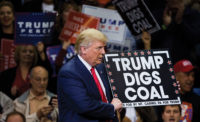In an attempt to speed construction of multistate pipelines, liquefied natural gas terminals and cross-border infrastructure projects, President Donald Trump has signed two broad executive orders directing agencies to change current review processes, including Section 401 permits under the Clean Water Act.
But it’s not clear how much the orders, signed April 10, will speed construction, says Fred Jauss, partner at the law firm Dorsey & Whitney and a former Federal Energy Regulatory Commission attorney. He says, “The executive order is designed to amplify pressure on state governments that are not providing certifications. Implementation of this order will undoubtedly end up in the courts.”
Larry Liebesman, senior adviser with water-resources consulting firm Dawson & Associates, says the order will send a message to states. “I think this is going to have a significant impact,”Liebesman says. “It’s really telling EPA to revise their regs and telling certifying states, this is how this is supposed to work. It tells states they shouldn’t drag out this process for political reasons.”
New York is one of a handful of states that has blocked projects under Section 401. In a statement, New York Gov. Andrew Cuomo (D) said the directive is a “gross overreach of federal authority.”
Oil, gas and electric-power interests welcomed the announcements, but environmental groups criticized the actions, which, among other things, require the Environmental Protection Agency to update its Section 401 interim guidance and rules within 60 days and publish a revised regulation within 120 days. The same order would require the Dept. of Transportation to update LNG safety rules.
A second executive order gives the president the sole authority to approve cross-border projects, including oil pipelines and bridges. The White House said the move will not affect existing cross-border permits.


